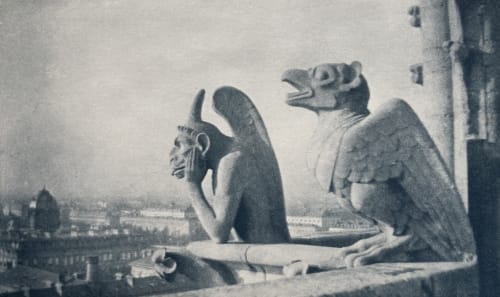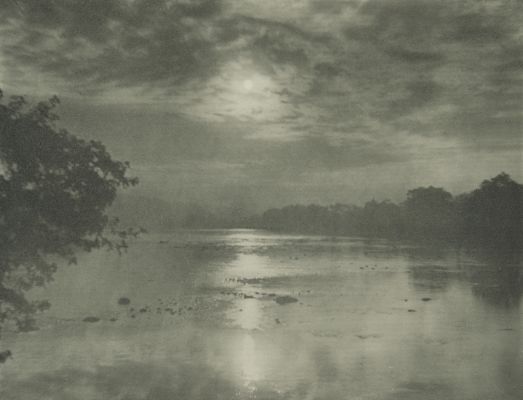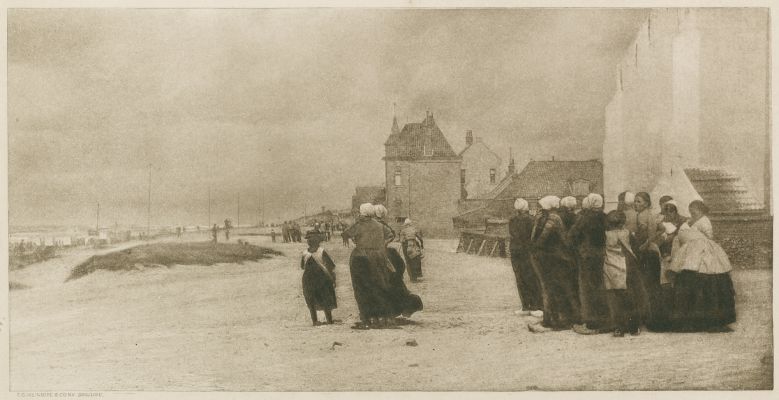
Title
Le Stryge, Notre DameArtist
Coburn, Alvin Langdon (American, 1882-1966)Key FigurePublication
The Photographic TimesDate
1902Process
PhotogravureAtelier
Photochrome Engraving Co.Image Size
10.0 x 16.4 cmSheet Size
17.1 x 24.9 cm
Le Stryge; Notre Dame is believed to date from 1901, when it was exhibited as a bromide print by Coburn during the Forty-sixth Annual Exhibition of the Royal Photographic Society in London in 1901. This example, showing slight blue tones, is a hand-pulled photogravure by the Photochrome Engraving Company of New York City was included in the February, 1902 issue of The Photographic Times.
The online catalogue for Exhibitions of the Royal Photographic Society 1870-1915 indicate Coburn’s study of two gargoyles watching over the city of Paris from a tower parapet of the Cathedral of Notre Dame was inspired by French artist Charles Méryon, (1821-1868) who had done an etching of the gargoyle at center in 1853 and titled it Le Stryge. (The Vampire) (Photoseed.com)
This photogravure is from the journal generally known as generally known as The Photographic Times, one of America’s earliest and most important photographic journals. The Times first appeared as a supplement incorporated within the pages of the monthly Philadelphia Photographer, one of the first journals devoted to photography published in America beginning in 1864. By 1889 issues were accompanied by well executed hand-pulled photogravure plates which appeared regularly until 1904. Due to changes in ownership or marketing strategies the name changed at least four times over the course of its 45 year run making keeping track of the specifics very difficult. This publication was an invaluable reference for the ever expanding photography movement in America at the turn of the century and published samples by the likes of Alfred Stieglitz, Gertrude Kasebier and Alvin Langdon Coburn. Initially it was geared to the professional photographer as would be expected, since it was published by the Scovil Manufacturing Co.; the articles mirrored their concerns. Reviews and reports from photographic societies were a regular feature. First edited by Edward Wilson, the editorship transferred to John Thraill Taylor, who enlarged the scope in 1880, when it became The Photographic Times and American Photographer. By 1882, an original mounted photograph was inserted, and in 1887, the size was increased to a large quarto, and fine photomechanical illustrations began appearing. It was becoming the preeminent American journal.
First published in 1871 as a supplement of The Philadelphia Photographer. It absorbed The American Photographer in 1879 to become The Photographic Times And American Photographer. In 1902, it merged with Anthony’s Bulletin to form The Photographic Times Bulletin. This periodical is most commonly cited as “The Photographic Times, Photographic Times Publishing Association. [1]
Reproduced / Exhibited
The Gargoyles of Notre-Dame Medievalism and the Monsters of Modernity By Michael Camille · 2008
References
[1] Many thanks to David Spencer for his research which can be found on Photoseed.com https://photoseed.com/blog/2012/11/25/march-of-trades-harmonious-shades-photographic-times/ (David Spencer, Photoseed)











